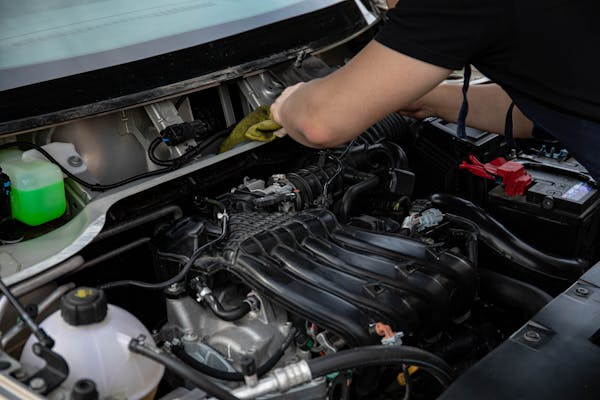
Check Engine Light? How Advanced Diagnostics Can Pinpoint the Problem
You’re driving along, everything seems fine—until that dreaded little amber light appears on your dashboard: the check engine light. It’s vague, it’s alarming, and worst of all, it doesn’t tell you what’s wrong. Should you pull over? Call a mechanic? Panic?
The truth is, a check engine light can signal anything from a loose gas cap to a serious engine malfunction. That’s where advanced diagnostics come in. At Advanced Auto Clinic in Niagara Falls, Ontario, we use cutting-edge tools and real-world expertise to translate your car’s warning signals into clear answers—and fast solutions.
Let’s explore why that light turns on, what advanced diagnostics involve, and how the team at Advanced Auto Clinic can get you safely back on the road.
Why the Check Engine Light Comes On
Modern vehicles are equipped with an onboard diagnostics system (OBD-II) that continuously monitors engine performance and emissions. When something deviates from normal operation, your vehicle’s computer logs a fault code and illuminates the check engine light.
Here are some common triggers:
- Loose or damaged gas cap
- Oxygen sensor failure
- Mass airflow sensor issues
- Catalytic converter problems
- Worn spark plugs or ignition coils
- Faulty thermostat or coolant temperature sensor
- Vacuum leaks
- Transmission issues
While some issues may be minor, others can affect your engine’s performance, fuel economy, and emissions—or even risk severe damage if ignored.
What Is Advanced Vehicle Diagnostics?
Vehicle diagnostics isn’t about guesswork—it’s about science, technology, and experience working together.
Advanced diagnostics refer to the process of using specialized tools and software to read your vehicle’s OBD-II codes, analyze real-time data, and pinpoint the exact source of a problem. This includes:
- Reading diagnostic trouble codes (DTCs)
- Accessing live sensor data
- Running systems tests
- Inspecting historical data and freeze-frame info
- Performing component-level analysis
At Advanced Auto Clinic, our technicians are trained to go beyond just reading the codes. We investigate the “why” behind them. For example, if your car shows an oxygen sensor fault, we determine whether the sensor itself is defective or reacting to another issue—like a vacuum leak or exhaust problem.
Why DIY Code Readers Fall Short
You might have seen or even used one of those small, plug-in code readers that claim to diagnose check engine lights. While handy, they only scratch the surface.
These devices typically show basic codes, like P0420 (catalyst system efficiency below threshold), without deeper context. They don’t reveal:
- Intermittent issues or complex data correlations
- Sensor waveform patterns
- Real-time adjustments made by the engine control module
- Emissions readiness status for inspection
Advanced diagnostics at a professional shop like Advanced Auto Clinic offer far greater accuracy, ensuring the right repair is made the first time—saving you time, money, and unnecessary part replacements.
The Diagnostic Process at Advanced Auto Clinic
Here’s what happens when you bring your car in for a diagnostic service at our shop in Niagara Falls:
Step 1: Interview and Inspection
We start by asking about symptoms you’ve noticed—strange sounds, reduced power, fuel smells, etc. We combine this with a visual inspection to check for obvious issues like disconnected hoses or visible damage.
Step 2: System Scan and Data Logging
We connect our professional scan tools to your vehicle’s OBD-II port and retrieve diagnostic trouble codes. We also monitor live data from your engine, transmission, and emissions systems to observe how your car is behaving in real time.
Step 3: Root Cause Analysis
Rather than just replacing parts based on codes, we follow a logical testing path. For example, if a misfire code is present, we check ignition components, fuel delivery, compression, and wiring to isolate the problem.
Step 4: Transparent Explanation and Plan
Once we identify the root cause, we walk you through the findings using plain language. You’ll know what’s wrong, why it matters, and what needs to be done to fix it.
Step 5: Expert Repair and Testing
After getting your go-ahead, our certified technicians complete the necessary repairs using quality parts. Then we clear the codes and retest the system to confirm the issue is resolved.
Real-World Example: A Misleading Oxygen Sensor Code
Let’s say your check engine light is on and the code reads P0130—indicating a faulty oxygen sensor. A quick-fix approach might be to replace the sensor. But at Advanced Auto Clinic, we dig deeper.
In one recent case, our technicians found that while the code pointed to the oxygen sensor, the real culprit was a cracked exhaust manifold allowing air to leak in and confuse the sensor readings. Replacing the sensor alone wouldn’t have solved the issue. By finding the true root cause, we saved the customer from repeat repairs—and got their vehicle running efficiently again.
Why Diagnostics Shouldn’t Be Delayed
Ignoring your check engine light can lead to:
- Worsening engine damage
- Reduced fuel economy
- Failed emissions tests
- Costly repairs down the road
- Breakdowns at the worst time
Advanced diagnostics take the guesswork out of repairs. When addressed early, many problems can be fixed quickly and affordably.
Trust Your Car to Niagara’s Experts
At Advanced Auto Clinic, we believe diagnostics are about more than machines—they’re about people who care. Our team has been serving the Niagara Falls community for over two decades, combining high-tech tools with good old-fashioned know-how.
We pride ourselves on transparency, meaning you’ll never feel pressured or left in the dark. From explaining every repair in detail to offering 24/7 drop-off options and valet service, we’re here to make your experience as smooth as possible.
Whether your check engine light just came on or you’ve been ignoring it for weeks, now’s the time to act.
Ready to find out what your check engine light is trying to tell you? Book your diagnostic appointment with Advanced Auto Clinic today!



